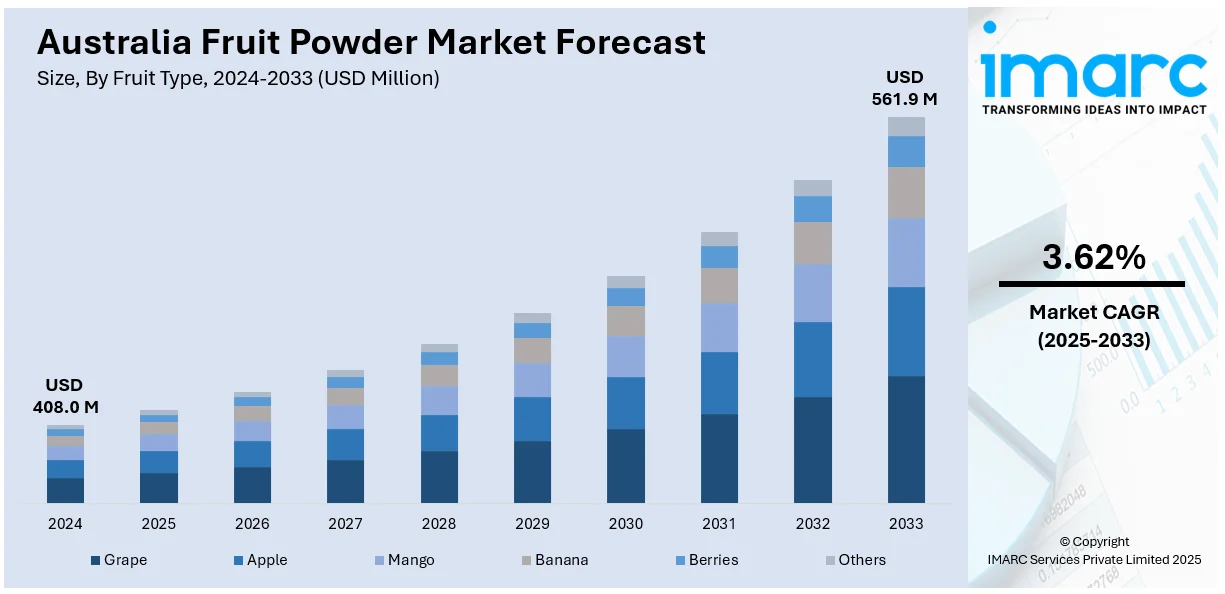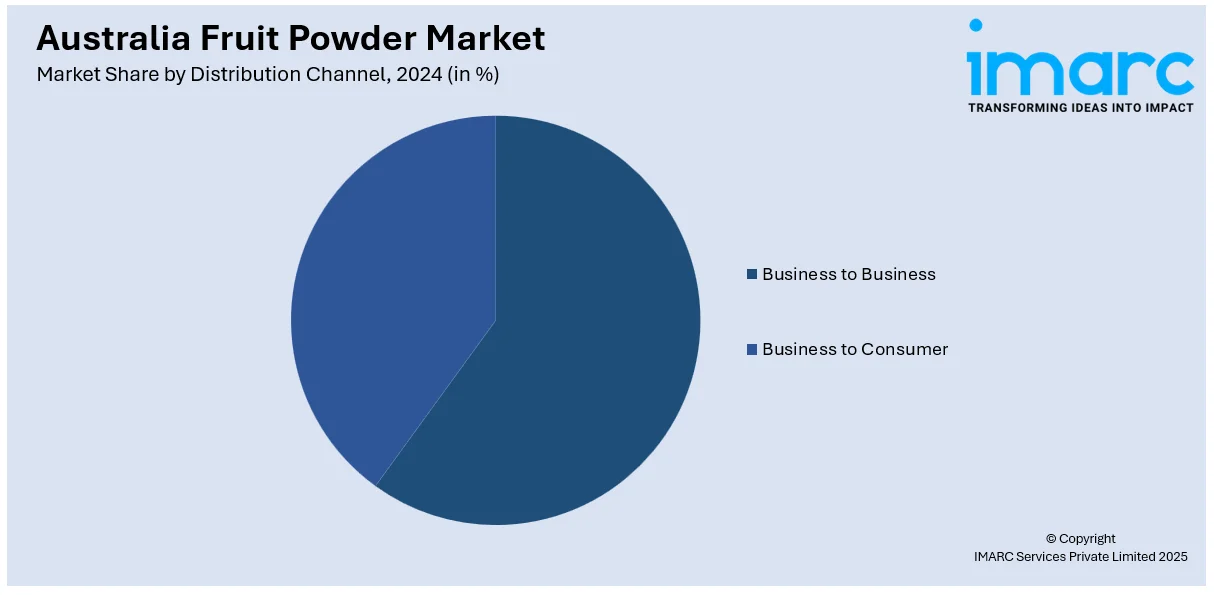
Australia Fruit Powder Market Size, Share, Trends and Forecast by Fruit Type, Technology, Distribution Channel, Application, and Region, 2025-2033
Australia Fruit Powder Market Overview:
The Australia fruit powder market size reached USD 408.0 Million in 2024. Looking forward, IMARC Group expects the market to reach USD 561.9 Million by 2033, exhibiting a growth rate (CAGR) of 3.62% during 2025-2033. The rising consumer preference for natural ingredients, increasing demand for convenient and long-shelf-life food products, innovations in drying technologies, expanding retail channels, and focus on clean-label formulations across the food processing industry, expanding health and wellness trends, and growing use of fruit powders in functional foods are some of the key factors augmenting Australia fruit powder market share.
|
Report Attribute
|
Key Statistics
|
|---|---|
|
Base Year
|
2024 |
|
Forecast Years
|
2025-2033
|
|
Historical Years
|
2019-2024
|
| Market Size in 2024 | USD 408.0 Million |
| Market Forecast in 2033 | USD 561.9 Million |
| Market Growth Rate 2025-2033 | 3.62% |
Australia Fruit Powder Market Trends:
Clean Label and Functional Nutrition Drive Market Growth
The Australia fruit powder market growth is driven by the increasing consumer demand for clean-label and functional nutrition products. Customers prefer minimally processed natural components that provide health advantages beyond simple sustenance. Fruit powders, which are made from whole fruits, offer a practical means of adding vital vitamins, minerals, and antioxidants to regular meals. Also, customers desire products free of artificial additives and preservatives, which is in line with the larger trend toward openness in food origins and labeling. Furthermore, fruit powders' adaptability enables their use in a variety of products, such as dietary supplements, baked foods, and smoothies. Busy lifestyles and increased health and wellness consciousness further fuel the demand for such accessible and nourishing solutions. According to an industry report, health consciousness among the Australian public is expected to rise by 0.5% in 2024-25, attaining 111.4 index points. This upward trend reflects a growing inclination toward healthier dietary choices, which is expected to influence demand for fruit-based products positively. As a result, manufacturers are innovating to offer a diverse range of fruit powder products that cater to these evolving consumer preferences.

To get more information on this market, Request Sample
Sustainability and Indigenous Ingredients Gain Traction
In the Australian fruit powder business, sustainability emerges as a key determinant of customer preferences. Eco-friendly methods, such as using recycled fruits and sustainable packaging, are becoming more and more popular. To lessen their carbon impact, manufacturers are increasingly using eco-friendly processing techniques and obtaining raw materials from certified sustainable farms. Indigenous Australian fruits that are high in nutrients and have distinctive flavors, including finger lime and Kakadu plum, are also gaining popularity. For instance, Monash University emphasized the potential of native Australian fruits, like finger limes and Kakadu plums, in advancing sustainable agriculture on March 12, 2025. These fruits, which need little water and are resistant to harsh weather, have evolved over millennia to flourish in Australia's harsh climate. Their incorporation into contemporary food systems presents a viable path toward the creation of resilient and ecologically sustainable farming methods. These native ingredients not only provide health benefits but also support local communities and biodiversity. The incorporation of such ingredients into fruit powders resonates with consumers seeking authentic and sustainable products, which in turn is positively impacting Australia fruit powder market outlook. This trend reflects a broader shift towards ethical consumption, where environmental and social considerations play a crucial role in purchasing decisions.
Australia Fruit Powder Market Segmentation:
IMARC Group provides an analysis of the key trends in each segment of the market, along with forecasts at the country level for 2025-2033. Our report has categorized the market based on fruit type, technology, distribution channel, and application.
Fruit Type Insights:
- Grape
- Apple
- Mango
- Banana
- Berries
- Others
The report has provided a detailed breakup and analysis of the market based on the fruit type. This includes grape, apple, mango, banana, berries, and others.
Technology Insights:
- Freeze Dried
- Spray Dried
- Vacuum Dried
- Drum Dried
A detailed breakup and analysis of the market based on the technology have also been provided in the report. This includes freeze dried, spray dried, vacuum dried, and drum dried.
Distribution Channel Insights:

- Business to Business
- Business to Consumer
- Supermarkets and Hypermarkets
- Food and Drink Specialty Stores
- Convenience Stores
- Online Stores
- Others
The report has provided a detailed breakup and analysis of the market based on the distribution channel. This includes business to business and business to consumer (supermarkets and hypermarkets, food and drink specialty stores, convenience stores, online stores, and others).
Application Insights:
- Bakery
- Confectionery
- Snacks and RTE Products
- Dairy
- Beverages
- Soups and Sauces
- Others
A detailed breakup and analysis of the market based on the application have also been provided in the report. This includes bakery, confectionery, snacks and RTE products, dairy, beverages, soups and sauces, and others.
Regional Insights:
- Australia Capital Territory & New South Wales
- Victoria and Tasmania
- Queensland
- Northern Territory & Southern Australia
- Western Australia
The report has also provided a comprehensive analysis of all the major regional markets, which include Australia Capital Territory & New South Wales, Victoria and Tasmania, Queensland, Northern Territory & Southern Australia, and Western Australia.
Competitive Landscape:
The market research report has also provided a comprehensive analysis of the competitive landscape. Competitive analysis such as market structure, key player positioning, top winning strategies, competitive dashboard, and company evaluation quadrant has been covered in the report. Also, detailed profiles of all major companies have been provided.
Australia Fruit Powder Market News:
- On April 2, 2025, Zest Element, an Australian food innovation firm, is bringing its line of 100% fruit powders produced from extra "wonky" fruit from nearby farms to the UK market. These nutrient-dense powders come in lemon, lime, orange, strawberry, Davidson plum, and anise myrtle flavors and are intended to improve food and drinks. The products have an 18-month shelf life and are available in 6kg pails and 150g pouches, which is equal to 60kg of fresh fruit.
Australia Fruit Powder Market Report Coverage:
| Report Features | Details |
|---|---|
| Base Year of the Analysis | 2024 |
| Historical Period | 2019-2024 |
| Forecast Period | 2025-2033 |
| Units | Million USD |
| Scope of the Report |
Exploration of Historical Trends and Market Outlook, Industry Catalysts and Challenges, Segment-Wise Historical and Future Market Assessment:
|
| Fruit Types Covered | Grape, Apple, Mango, Banana, Berries, Others |
| Technologies Covered | Freeze Dried, Spray Dried, Vacuum Dried, Drum Dried |
| Distribution Channels Covered |
|
| Applications Covered | Bakery, Confectionery, Snacks and RTE Products, Dairy, Beverages, Soups and Sauces, Others |
| Regions Covered | Australia Capital Territory & New South Wales, Victoria and Tasmania, Queensland, Northern Territory & Southern Australia, Western Australia |
| Customization Scope | 10% Free Customization |
| Post-Sale Analyst Support | 10-12 Weeks |
| Delivery Format | PDF and Excel through Email (We can also provide the editable version of the report in PPT/Word format on special request) |
Key Questions Answered in This Report:
- How has the Australia fruit powder market performed so far and how will it perform in the coming years?
- What is the breakup of the Australia fruit powder market on the basis of fruit type?
- What is the breakup of the Australia fruit powder market on the basis of technology?
- What is the breakup of the Australia fruit powder market on the basis of distribution channel?
- What is the breakup of the Australia fruit powder market on the basis of application?
- What is the breakup of the Australia fruit powder market on the basis of region?
- What are the various stages in the value chain of the Australia fruit powder market?
- What are the key driving factors and challenges in the Australia fruit powder market?
- What is the structure of the Australia fruit powder market and who are the key players?
- What is the degree of competition in the Australia fruit powder market?
Key Benefits for Stakeholders:
- IMARC’s industry report offers a comprehensive quantitative analysis of various market segments, historical and current market trends, market forecasts, and dynamics of the Australia fruit powder market from 2019-2033.
- The research report provides the latest information on the market drivers, challenges, and opportunities in the Australia fruit powder market.
- Porter's five forces analysis assist stakeholders in assessing the impact of new entrants, competitive rivalry, supplier power, buyer power, and the threat of substitution. It helps stakeholders to analyze the level of competition within the Australia fruit powder industry and its attractiveness.
- Competitive landscape allows stakeholders to understand their competitive environment and provides an insight into the current positions of key players in the market.
Need more help?
- Speak to our experienced analysts for insights on the current market scenarios.
- Include additional segments and countries to customize the report as per your requirement.
- Gain an unparalleled competitive advantage in your domain by understanding how to utilize the report and positively impacting your operations and revenue.
- For further assistance, please connect with our analysts.
 Request Customization
Request Customization
 Speak to an Analyst
Speak to an Analyst
 Request Brochure
Request Brochure
 Inquire Before Buying
Inquire Before Buying




.webp)




.webp)












